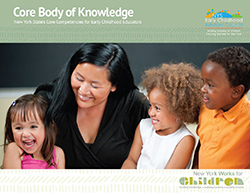
Core Body of Knowledge
New York State's Core Competencies for Early Childhood Educators

4.8
Resources for Competency 4.8:
click to view resource list
Sustains Active Engagement with Children
The professional working with young children uses approaches to learning that build on children's natural curiosity, deepen children's knowledge and awareness, and sustain active engagement with ideas and materials
Resources & Media for Understanding Competency 4.8
Behaviors & Skills
-
aAssesses children's interests, learning styles, strengths and challenges and uses that knowledge to meet children's instructional and social needs
-
bEnsures that play is an integral part of the curriculum
-
cEncourages child-directed learning, rather than learning that is dependent on adult direction
-
dAttends to children's curiosity and interests to determine how to engage them with new concepts and skills
-
eMakes learning visible to children, families, colleagues and self through documentation
-
fHelps children identify and apply prior knowledge
-
gPoses problems and asks questions that provoke children's thinking and curiosity
-
hValues and encourages inquiry
-
iHelps children learn how to think about a topic, question or problem, rather than what to think about it
-
jHelps children express their ideas
-
kEncourages children to use their bodies in dance, drama, costume, music and art
-
lEnsures that children have plenty of opportunity to practice emerging skills
-
mProvides opportunities for children to revisit experiences and materials again and again so they are able to deepen their understanding
-
nEncourages and supports children to prolong an activity that they show interest in
-
oIs able to put plans on hold to focus on a meaningful concept or experience that a child might introduce
-
pAdjusts the level of support he or she provides to children depending on their abilities
-
qWhen necessary, breaks tasks or activities down into smaller parts so that children are able to understand them and carry them out on their own
-
rUses daily small group experiences, activities, and/or interactive read aloud to support children’s development and learning
